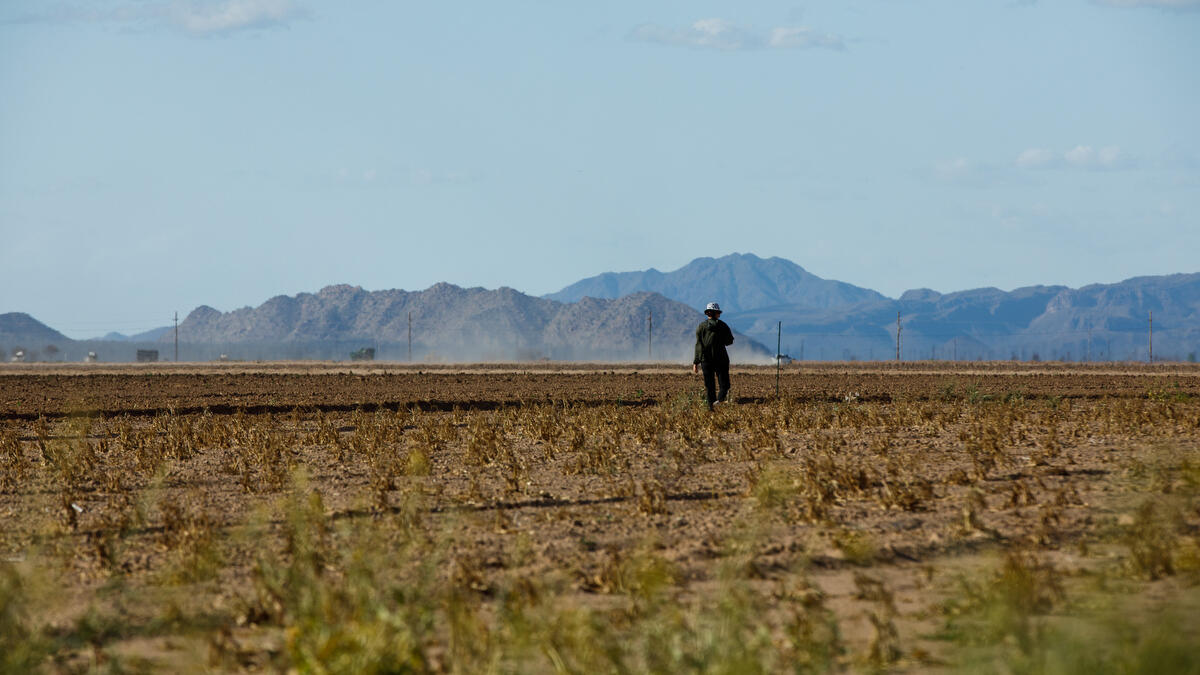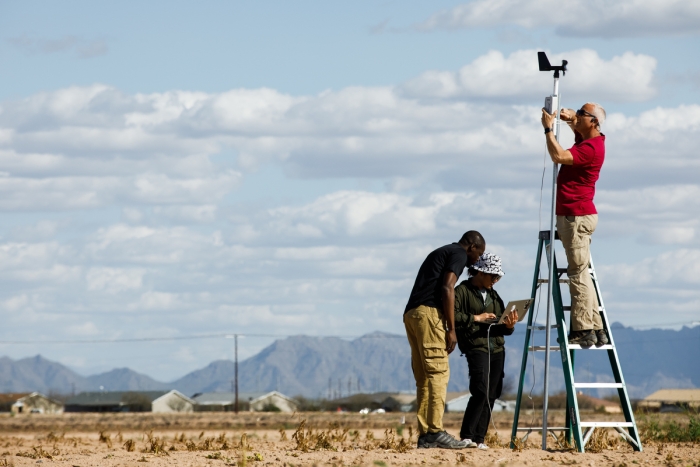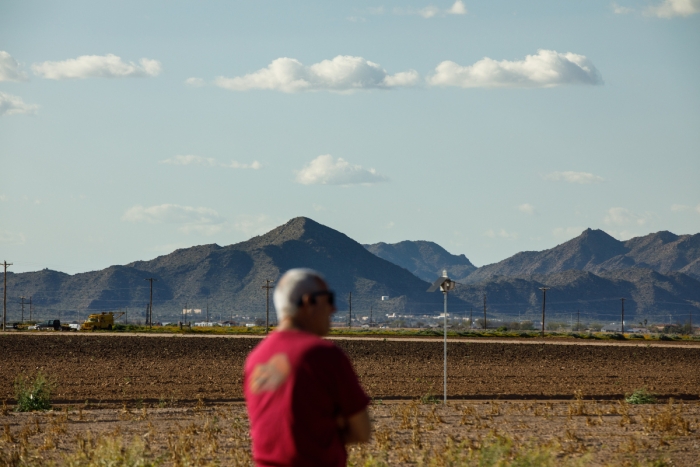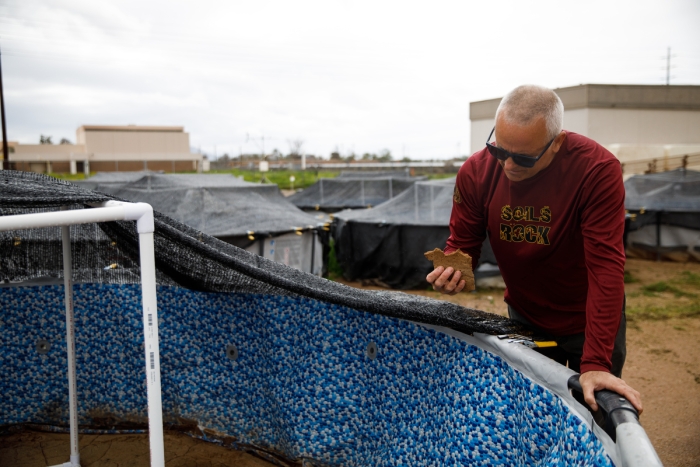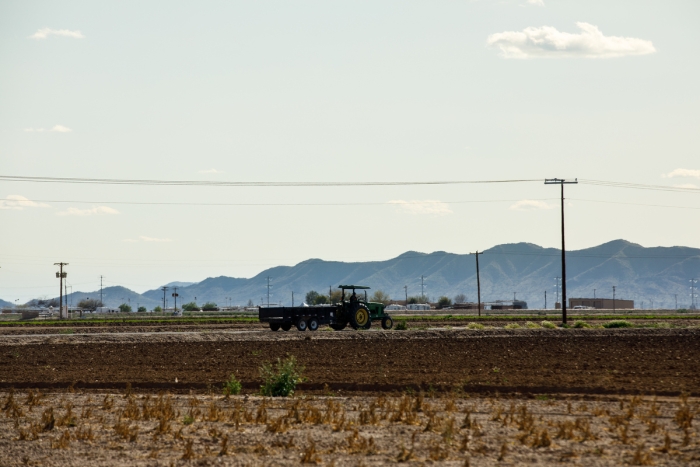Many people, when they first visit Arizona, expect to find sand on the floor of its famous Sonoran Desert. What they find, instead, is dust.
Fine as flour, this dust sits atop hardened soil, where it is easily carried off by the wind. When the winds are strong, the results can be severe: irritated lungs, blinded drivers and felled trees beneath dust clouds that swallow cities.
The compacted earth from which this dust is born looks barren. But there is a secret web of dynamic life woven through this dirt. Nurturing this life may well be the key to reducing Arizona’s airborne dust.
Biocrust (pictured above) is a mesh of bacteria that, like plants, get their energy from sunlight. They can be found in nearly any place in the world that has a dry climate and little vegetation. In Arizona’s desert, biocrust holds down dust like a sticky net.
“They grow in these long filaments and they kind of weave themselves together like a tapestry. It’s basically like throwing a carpet over the surface,” says Brian Scott, shown above installing a dust monitor. Scott is a postdoctoral researcher at the Biodesign Center for Fundamental and Applied Microbiomics, which is directed by Regents Professor Ferran Garcia-Pichel.
RELATED: ASU Regents Professor awarded for pioneering approach to soil restoration
Human activity, including farming and construction, disturbs the native layer of biocrust on top of the desert soil. When the biocrust is gone, it leaves behind a surface layer of exposed, loose dust that can feed dust storms.
It can take decades for biocrust to grow back on its own and gain enough ground to suppress that dust once more. But Scott is working in Garcia-Pichel’s lab (as shown below) to hone that regrowth process down to just a year or two.
The team is cultivating biocrust in the lab with the goal of planting it in biocrust-depleted areas like abandoned farm fields, which are the biggest sources of dust.
Biocrust grows readily enough in the lab’s controlled settings, but when it’s moved to the wild, it dies. The challenge is to grow heartier biocrust that can thrive and grow in harsh desert conditions. Scott and the team are testing how biocrust growth responds to factors like soil type and bacterial composition.
“Biocrust is a colony of different microorganisms, and when we grow it, we have to be careful that we maintain the integrity of the community,” Scott says. “There are many organisms involved, and if you take a few of them out, the whole thing falls apart.”
To make sure all the right bacteria are present in the right amounts, the researchers sequence the DNA of the biocrusts they cultivate. Once a biocrust is successfully transplanted to the wild, it will become more complex by adding organisms like fungi and algae to its community.
Not all land areas have the same uses or needs, so reducing dust effectively means developing and field-testing a combination of solutions. (Above, Scott examines one of the biocrust test beds at the Polytechnic campus.)
Planting biocrust is a long-term solution to control dust from abandoned land and restore the native ecosystem. But farmers also need a short-term solution for fields that they leave fallow for just a season.
Researchers from the center worked with local Casa Grande farmer Patrick Dugan, owner of Du-Brook Dairy Inc., who provided plots of land where they could test their solutions. (Below, Assistant Professor Emmanuel Salifu and graduate student Thuong Cao install a dust monitor at the dairy.)
“Being environmentally friendly was important to me,” Dugan says. “The farmers — we want to be a part of the solution, too.”
While Scott focuses on biocrust treatment, another group from the center is working on creating a treatment that uses chemistry to temporarily harden the topsoil. It works by forming a layer of calcium carbonate, a compound found in materials like limestone and eggshell.
This technique mimics a natural process called abiotic crusting, through which the soil’s properties allow it to harden on its own. Scott believes that adjusting the timing of weeding and field plowing could be a simple solution that allows this type of soil to crust before monsoon storms begin.
Much is known about dust storms, biocrusts, soils and land-use practices, but this research is unique for bringing all these puzzle pieces together to examine the system as a whole.
However, it’s a complicated issue, Scott acknowledges. Addressing dust storms will require updates to policy, including water allocation, as well as buy-in from more farmers and rural communities. The center is currently working on creating an integrated plan. As they do so, they seek input from farmers and the Arizona Department of Environmental Quality.
“Part of our job is to help sort all that out and put it into something that's actionable,” Scott says. “I think we have a good chance, if we could implement those measures, that the severity of dust storms would go down.”
Watch video
This research is supported by the Arizona Board of Regents. Photography and content direction by Andy DeLisle
More Science and technology

Training stellar students to secure semiconductors
In the wetlands of King’s Bay, Georgia, the sail of a nuclear-powered Trident II Submarine laden with sophisticated computer equipment juts out of the marshy waters. In a medical center, a cardiac…

ASU startup Crystal Sonic wins Natcast pitch competition
Crystal Sonic, an Arizona State University startup, won first place and $25,000 at the 2024 Natcast Startup Pitch Competition at the National Semiconductor Technology Center Symposium, or NSTC…

Celebrating '20 Years of Discovery' at ASU’s Biodesign Institute
Editor’s note:The Biodesign Institute at Arizona State University continues to celebrate its landmark 20th anniversary with this fifth installment in its "20 Years of Discovery" series. Each…
